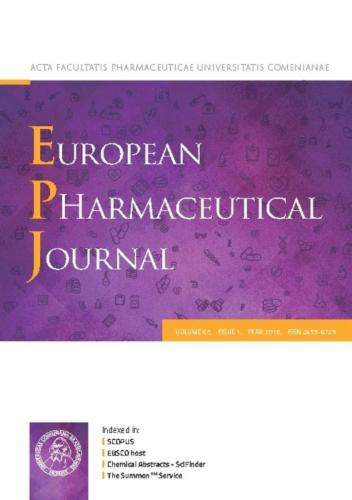一种新的来曲唑长效注射制剂的释放特性模型的开发和评价
IF 4.7
3区 医学
Q1 PHARMACOLOGY & PHARMACY
引用次数: 0
摘要
治疗乳腺癌等慢性疾病通常需要长期每天口服药物,这与不坚持处方治疗有关,可能导致疾病进展。为了解决口服给药的缺点,同时提高生物利用度、血浆水平可变性或治疗依从性,诸如长效注射(LAI)植入物等新的给药策略已经进入人们的研究领域。这促使了一种新的聚合物和可生物降解原位形成长效来曲唑植入物的发展。这个新配方作为一个套件提供了两个注射器(其中一个含有来曲唑和聚乳酸,另一个含有二甲亚砜作为溶剂的重组)。一旦配方重组并注射到肌肉中,溶剂扩散到组织液中,不溶性聚合物沉淀,形成半固体植入物,捕获原料药并允许药物持续释放。为了优化处方和开发过程,我们进行了传统的体外溶出度评估和预测溶出度建模,以确定哪些配方特征对释放动力学有影响,这可能为未来与临床前和临床数据建立体外体内相关性(IVIVC)提供第一个基础。采用实时溶出法和加速溶出法对15种来曲唑LAI配方的体外溶出曲线进行了描述。使用威布尔分布和估计注射过程中剂量损失的分数来描述释放曲线是最好的。在加速条件下,一级释放速率常数(KD)提高了1.87倍;在高粘度和低粘度条件下,一级释放速率常数分别降低了30%和1.34倍。这项工作允许定量表征负责控制药物释放的制剂相关特征。它提供了对配方的新理解,将有助于指导稳健配方的开发和建立产品质量控制规范。本文章由计算机程序翻译,如有差异,请以英文原文为准。

Development and evaluation of a model characterizing the release characteristics of a new letrozole long-acting injectable formulation
Treating a chronic condition such as breast cancer usually requires daily oral drug administration for extended periods of time, which is associated with non-adherence to the prescribed therapy that may cause disease progression. New delivery strategies such as long-acting injectable (LAI) implants have entered the picture in order to solve oral administration drawbacks while improving bioavailability, plasma levels variability or treatment compliance. This has motivated the development of a new polymeric and biodegradable in situ forming long-acting implant of letrozole. This new formulation is provided as a kit of two syringes (one of them containing letrozole and Poly-Lactic Acid, and the other one containing dimethyl sulfoxide as solvent for reconstitution). Once the formulation is reconstituted and injected into the muscle, the solvent diffuses into tissue fluids and the insoluble polymer precipitates, forming a semi-solid implant that traps the API and allows a sustained drug release. In order to optimize both the formulation and the development process, traditional in vitro dissolution assessment and predictive dissolution modelling were conducted to identify which formulation characteristics show an impact on the kinetics of the release, which may provide a first basis to potentially establish an in vitro-in vivo correlation (IVIVC) with both pre-clinical and clinical data in the future. Two dissolution methods (real-time and accelerated) were used to describe the in vitro dissolution profiles of 15 letrozole LAI formulations differing on their Critical Material Attributes (CMAs). The release profiles were best described using the Weibull distribution and estimating the fraction of the dose loss during injection. The first order rate constant of release (KD) was increased by 1.87 times in the case of the accelerated conditions, and was 30 % reduced and increased by 1.34 times in the case of higher and lower viscosity of the formulations, respectively. This work allowed for quantitative characterization of the formulation related characteristics responsible for controlling drug release. It provides a new understanding of the formulation that will serve to guide in the development of a robust formulation and to establish product quality control specifications.
求助全文
通过发布文献求助,成功后即可免费获取论文全文。
去求助
来源期刊
CiteScore
9.60
自引率
2.20%
发文量
248
审稿时长
50 days
期刊介绍:
The journal publishes research articles, review articles and scientific commentaries on all aspects of the pharmaceutical sciences with emphasis on conceptual novelty and scientific quality. The Editors welcome articles in this multidisciplinary field, with a focus on topics relevant for drug discovery and development.
More specifically, the Journal publishes reports on medicinal chemistry, pharmacology, drug absorption and metabolism, pharmacokinetics and pharmacodynamics, pharmaceutical and biomedical analysis, drug delivery (including gene delivery), drug targeting, pharmaceutical technology, pharmaceutical biotechnology and clinical drug evaluation. The journal will typically not give priority to manuscripts focusing primarily on organic synthesis, natural products, adaptation of analytical approaches, or discussions pertaining to drug policy making.
Scientific commentaries and review articles are generally by invitation only or by consent of the Editors. Proceedings of scientific meetings may be published as special issues or supplements to the Journal.

 求助内容:
求助内容: 应助结果提醒方式:
应助结果提醒方式:


